The Intel SSD 540s (480GB) Review
by Billy Tallis on June 23, 2016 9:00 AM ESTRandom Read Performance
The random read test requests 4kB blocks and tests queue depths ranging from 1 to 32. The queue depth is doubled every three minutes, for a total test duration of 18 minutes. The test spans the entire drive, which is filled before the test starts. The primary score we report is an average of performances at queue depths 1, 2 and 4, as client usage typically consists mostly of low queue depth operations.
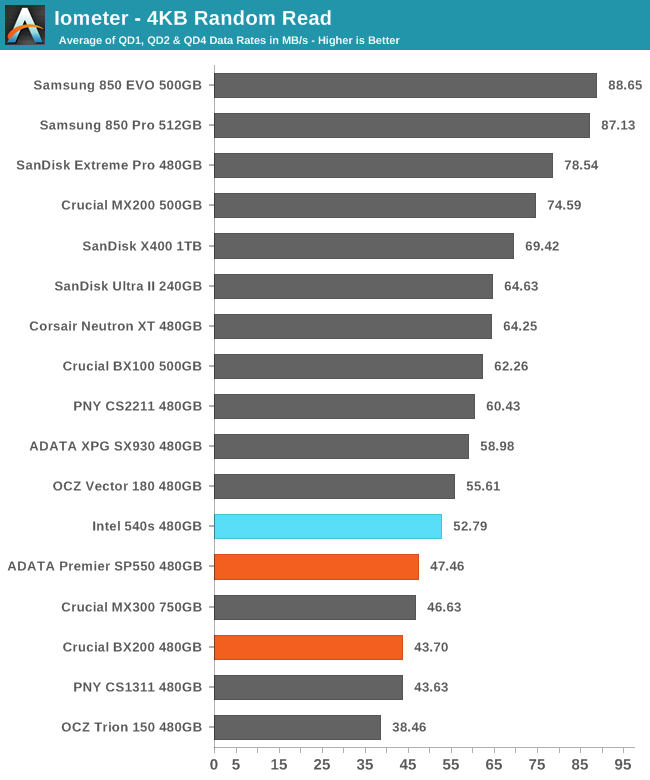
The random read speed of the Intel 540s is a significant improvement over both SM2256 drives and Phison S10 TLC drives, but isn't quite as fast as the MLC drives or SanDisk and Samsung TLC.
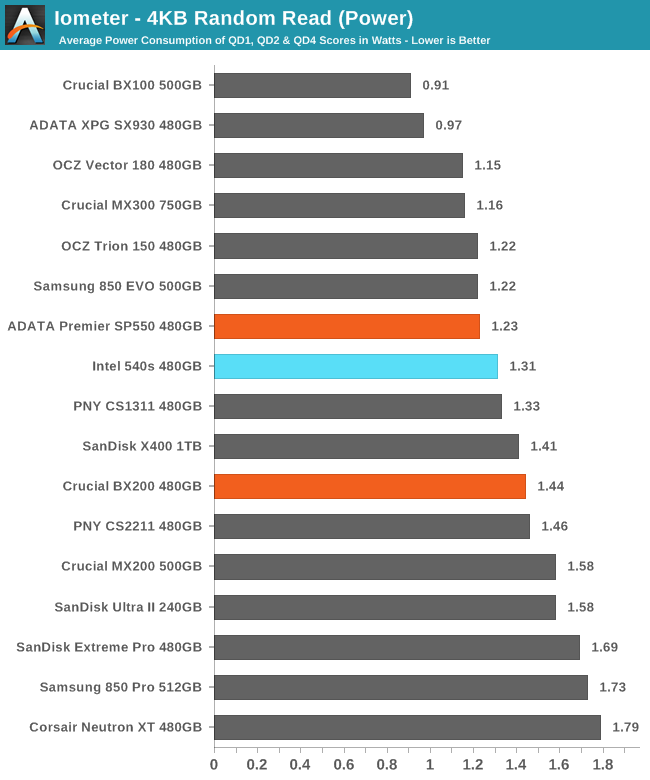
Power usage of the Intel 540s was slightly higher than the SP550, but given the performance increase their efficiency is similar and good overall.
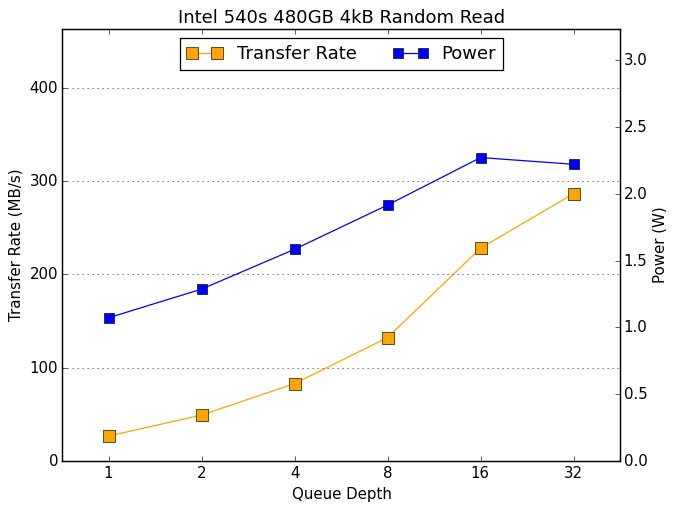 |
|||||||||
The Intel 540s drew more power and delivered more performance than the SP550 at every queue depth until QD32, where the SP550 performed slightly better.
Random Write Performance
The random write test writes 4kB blocks and tests queue depths ranging from 1 to 32. The queue depth is doubled every three minutes, for a total test duration of 18 minutes. The test is limited to a 16GB portion of the drive, and the drive is empty save for the 16GB test file. The primary score we report is an average of performances at queue depths 1, 2 and 4, as client usage typically consists mostly of low queue depth operations.
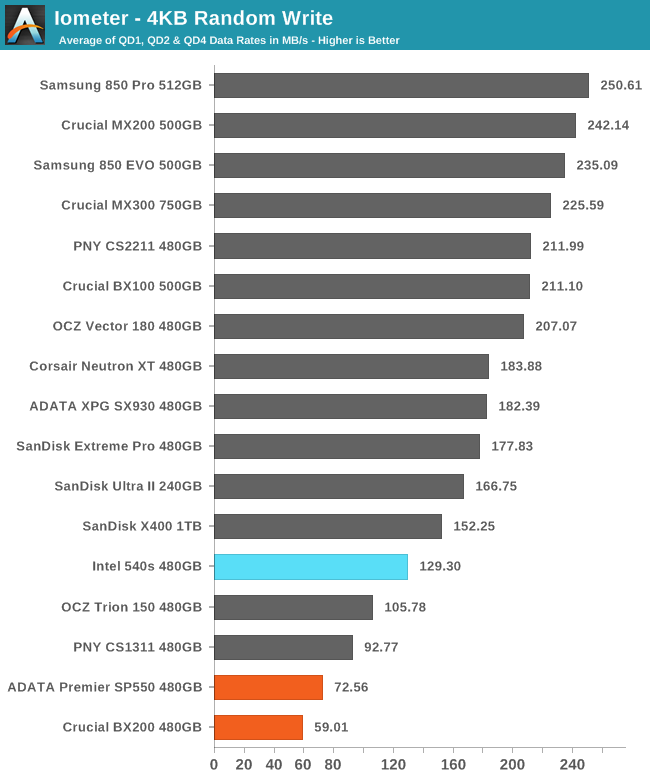
The Intel 540s shows almost double the performance on the random write test that the SM2256 drives did. This puts it well ahead of the Phison-based TLC drives and close to SanDisk's TLC drives.
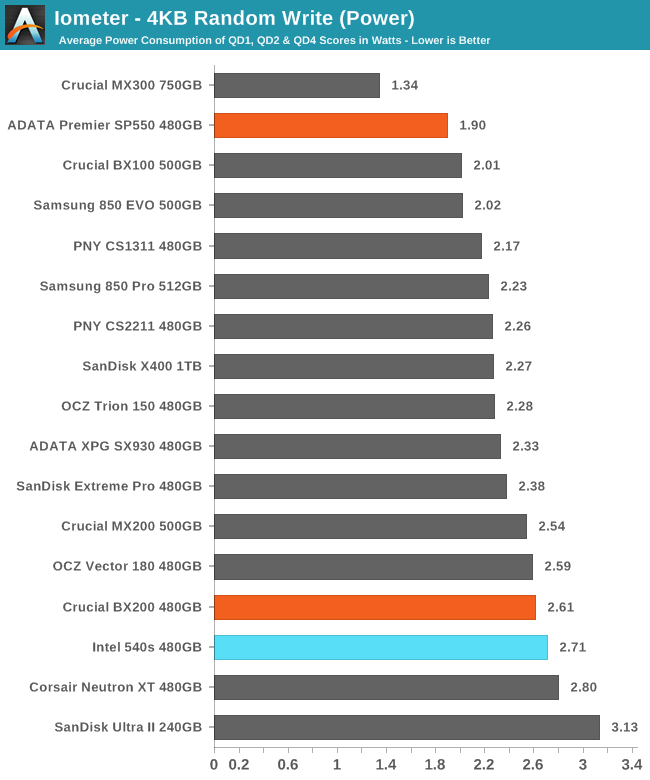
The Intel 540s had relatively high power draw during the random test, but it certainly wasn't the least efficient drive.
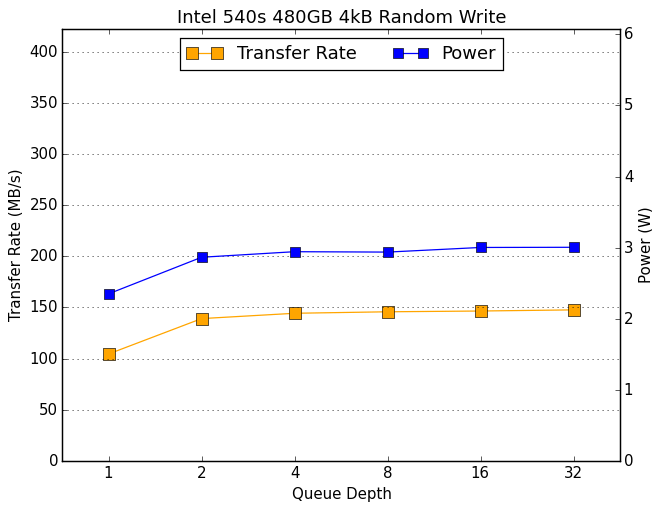 |
|||||||||
The random write performance of the Intel 540s increases moderately from QD1 to QD2 and only very slightly after that. The SM2256 drives started out slower and stayed there, though the BX200 drew more power with higher queue depths. Most budget TLC drives show relatively little scaling with queue depth here, with a few exceptions like the OCZ Trion 150 jumping up from QD4 and QD8.










77 Comments
View All Comments
Flunk - Thursday, June 23, 2016 - link
Looks like it's on Intel's low-end product map for well into 2017 (which is as far as that goes).BurntMyBacon - Friday, June 24, 2016 - link
I thought that Intel's low-end was the 300 series. Apparently not anymore:https://benchlife.info/mansion-brighton-stony-beac...
Please post another link to a roadmap if you find one not plastered with a website logo.
JKJK - Thursday, June 23, 2016 - link
520 and 530 stuck with us for forever, even still when they where performance wise surpassed by other manufacturers. And the price didn't budge either, so I suppose 540 will be with us for a while.However, I'm pretty disappointed with Intel on this one. Samsung 750 evo and even 850 evo is way cheaper here in Norway.
Impulses - Thursday, June 23, 2016 - link
They're at price parity in the US right now, 'course the EVO is much better for the money...Flunk - Thursday, June 23, 2016 - link
That's a lot of money to pay for a low-end drive with a Silicon Motion controller. Performance like a Trion, price like an 850 Evo. Good work Intel.BrokenCrayons - Thursday, June 23, 2016 - link
In their defense, it's not a terrible performer relative to other planar TLC drives with the same controller. However, that doesn't excuse the much higher price MSRP. Were I in the market for a new drive, I wouldn't write off TLC, but I would write off the 540 right away based on the cost over its nearest competitors.Guspaz - Thursday, June 23, 2016 - link
So, it's an Intel SSD that doesn't use an Intel controller, doesn't use Intel flash, and provides terrible performance at a much higher prices than the competition.What were they thinking? I've always been a bit of an Intel SSD fanboy (the five standalone SSDs that I've bought over the years have all been Intel, all the way back to the G1), but they've clearly lost their way, and I don't think the next SSD that I buy would be an Intel.
hojnikb - Thursday, June 23, 2016 - link
They probably want to bank on the clueless users, that have little idea of SSD performance but know Intel as a brand.BurntMyBacon - Friday, June 24, 2016 - link
@Guspaz: "So, it's an Intel SSD that doesn't use an Intel controller, doesn't use Intel flash, and provides terrible performance at a much higher prices than the competition."They did use Sandforce controllers for a while. Though their performance was pretty decent at the time. Firmware made the difference in reliability. Since they are still doing their own firmware and validation, I don't think the use of a third party controller or flash is an insurmountable problem. I do think that the product is not priced or named correctly. This should be a 300 series part with a 300 series price.
Note: The relatively high price may be correlated with the fact that they have to acquire flash on the open market and not everything they get is necessarily meeting their validation requirements.
pwil - Wednesday, July 27, 2016 - link
3 in 3xx series means 3y warranty.